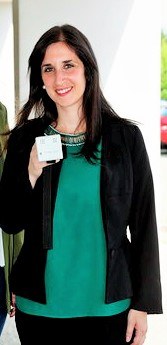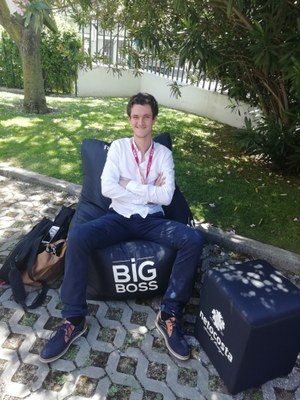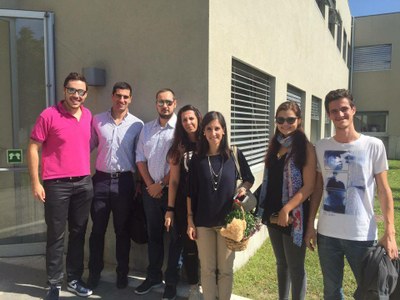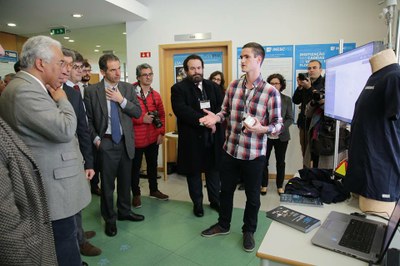Limelight
In a universe of more than 1200 collaborators, there are many months when there is more than one collaborator with a performance suitable for “Limelight”. An example of this is the fact that for several months we receive more than one nominee. This led to a change in the publication policy: BIP has started to highlight all nominees, without considering the merit (because all nominees have much merit!). Additionally, considering the criteria for news opportunity, an interview with one of the nominees is developed.
THIS MONTH WE SPOKE WITH SUSANA RODRIGUES anD DUARTE DIAS (C-BER)
1. [Susana] Your core training is in Psychology. How does this fits to the work developed at INESC TEC?
Yes, it’s true. My training is in Psychology with specialisation on Clinical and Health Psychology. It was during my PhD project (2012-2016), under the co-supervision of Professor João Paulo Cunha, that I got in touch with C-BER. My involvement in this group has allowed me to obtain/develop more technical skills in the different areas that the group works (for example, biomedical engineering, computer science). C-BER has a research line related to Occupational Health and the study of processes such as the stress, fatigue, and for its degree of complexity, it should be carried out in a multidisciplinary perspective. Psychology provides us tools for a better comprehension of the mental and behavioural processes that are associated to the mental health, being essential for the design of research plans applicable to the experimental and ecological contexts. Considering stress as an example, in Psychology the data collected is essentially descriptive, subjective and often analysed through more qualitative approaches. Using technological tools, as is the case of a wearable platform developed by the group, allows the measurement and the personalisation of the samples which are supported by more strict/assertive data as well as a better assessment of the impact of stress in health. These tools are essential so more sustainable diagnosis are carried out and subsequently more effective interventions in the mental heath area are designed.

2. [Duarte] How did the opportunity of working at C-BER/ INESC TEC emerged?
My Master thesis in Bioengineering (FEUP) was developed at INESC TEC in the C-BER's research group in biomedical instrumentation, which is one of the strengths of this research centre. When I was at the final stage of the thesis, I was invited by Professor João Paulo to join the group after I completed my degree. As I was still not sure about what I was going to do after I completed my degree, I accepted the proposal and so far I haven’t stopped growing professionally in this centre that every month has new challenges, new goals and several R&D areas, which for me is great because it allows me to increase my knowledge at several levels. What only seems to have been a change of buildings (FEUP -> INESC TEC) was in fact a change that has already had many milestones in my professional life and which has positively contributed to this research centre.

3. [Susana] This nomination is made under the application for European projects. What has been your contribution in these applications?
Regarding the two European projects that we submitted, my involvement starts from the identification and contact with the partners, to the establishment of the consortium and finally to the actual writing of the proposal. In one of the projects, I played the role of coordinator. In both projects, INESC TEC takes the lead, making our task even more demanding. The challenge was to manage the involvement of a large consortium and to prepare proposals within a limited time period. However, the work of the team, and essentially the perseverance, the optimism and the calmness of Duarte were essential for the success of our work. All we can do now is to hope that the results are favourable.

4. [Duarte] What challenges does the work at INESC TEC still present?
One of the biggest challenges as a member of C-BER was having to develop multidisciplinary skills in order to be able to "attack" on several fronts: being a biomedical engineering centre, we address and make new developments and research in several areas such as programming, electronics, psychology, medicine, management , so I have to interconnect, study, understand and innovate, always taking into account the diverse scopes and applications. As I began to bridge the gap between several members of the group, I had to be able to have that ability and that alone was a challenge. In the most recent months, I have been involved in a different challenge of building, writing and submitting some projects proposals in order to go ahead with our ideas of the centre. From now on, I think that the next challenge will be to help C-BER grow as a centre at INESC TEC, both at a scientific level (which in my opinion already has a Michelin star) as well as at a structural level in order to stimulate the area of biomedical engineering that has been growing a lot in recent years.

5. We will end this interview by asking you to comment on your nomination by the C-BER Coordination:
«The coordinators of C-BER suggest the nomination of Susana Rodrigues and Duarte Dias for their very important contribution to the new projects of the centre. After C-BER gained scientific critical mass since its relatively recent creation, this team, with its commitment and motivation, was the main internal driving force for the submission of the first two H2020 proposals that C-BER coordinates (one of about EUR 6.5 million and another of about EUR 4 million). We believe this “achievement” is of great strategic relevance for C-BER and for INESC TEC.»
First of all, we want to thank our coordination for this nomination, we always do our best and it is always good to see our work being recognised. Our experience in European projects was very small, which entailed a great deal of studying and learning through the reading of support documents and researches, besides the elaboration of the proposal itself. We also can’t forget to thank the constant availability and the spirit of mutual help between colleagues of other centres with more experience and success in similar applications, the exchange of ideas and important tips in the writing of the proposals. Our motivation of making the group bigger and our desire to learn more, as each partner brings relevant know how, has led us to accept this challenge promptly and also to make the most of it for us to grow professionally. For us, a task that pull us out of our “comfort zone” is always good because it challenges our BRAIN to work at 110%.


